Production of sivacon 8pt
Schematic diagram of SIVACON enclosures:
- Cabinet construction
- Frame and Enclosure
- Busbar system types
- Type FCB1 and BC enclosures
- Type OFW cubicles (withdrawable modules)
- Type OFPM cubicles (plug-in units)
- PFC panels (reactive power compensation)
- Cabinets of CCS type (free design cabinet)
SIVACON 8PT technology is a modern modular solution of distribution systems from a world famous manufacturer, allowing to meet any customer requirements for the distribution, and allowing at any time to perform maintenance, repair and replacement of its components, without shutting down the entire installation.
SIVACON8PT cabinets are designed for the distribution of electrical power up to 690V AC up to 7400A. They can be used in all areas of power generation, transmission and distribution.
SIVACON applications:
- Power plants;
- Distribution cabinets for buildings and structures;
- Switchgear substations;
- Main switchboards and auxiliary electrical systems for the power, chemical, oil, gas and other industries.

Technical Data
| Rules and Regulations |
|
|
| Air gaps and leakage distances |
|
|
| Rated insulation voltage (Ui) | 1000V | |
| Rated operating voltage (Ue) | Up to 690V | |
| Rated current (In) Busbars (3- and 4-pole) | Main horizontal busbars | Rated current up to 7400A Rated withstand pulse current (Ipk) up to 375kA Rated short-time withstand current (Icw) up to 150kA, 1s up to 120kA, 3s |
| Vertical busbars for circuit breakers | Rated current up to 6300A Rated withstand pulse current (Ipk) up to 250kA Rated short-time withstand current (Icw) up to 80kA, 3s; up to 100kA, 1s | |
| Vertical busbars for rigid structure | Rated current up to 1400A Rated withstand pulse current (Ipk) up to 163kA Rated short-time withstand current (Icw) up to 65kA*, 1s; up to 50kA, 3s | |
| Vertical busbars for plug-in units | Rated current up to 1200A Rated withstand pulse current (Ipk) up to 163kA Rated short-time withstand current (Icw) up to 65kA*, 1s; up to 50kA, 3s | |
| Vertical busbars for withdrawable assembly | Rated current up to 1200A Rated withstand pulse current (Ipk) up to 163kA Rated short-time withstand current (Icw) up to 65kA*, 1s Up to 50kA, 3s | |
| Design currents of apparatuses | Circuit breakers up to 6300A Outgoing feeders up to 630A | |
| Internal division | From Form 1 to Form 4 | IEC 60439-1, Section 7.7, DIN EN 60439-1 |
| Exterior surface treatment | frame, casing, doors | Galvanizing / powder coating / wet painting Zinc plating / powder coating / wet paint Powder coating / wet painting |
| Protection level | To IEC 60529, EN 60529 | IP 30 to IP 54 |
| Dimensions |
|
|
| *Conditional rated | short-circuit current Icc up to | 100 kA |
Modular technology makes it possible to optimally adapt the SIVACON to any requirements.

Cabinet design
SIVACON adapts to customer requirements
Structurally, SIVACON 8PT cabinets can be divided into 5 compartments:
- – apparatus compartment
- – Horizontal busbar compartment
- – Cable entry compartment
- – Secondary circuit compartment
- – Cable compartment for cable connection from the rear or from above.
- Cabinets of CCS type (free design cabinet)
The main features of SIVACON:
- Typical tested standard equipment combinations (TTA)
- Standardized busbar position at the top/rear of the enclosure
- 3 and 4-pole busbar system for currents up to 7400 A
- Rated impulse withstand current Ipk up to 375 kA
- Deep equipment compartment for universal installation
- Modular busbar compartment structure
- Installation single-sided or back-to-back
- Cable entry from above or below
- All components can be installed in the device compartment, irrespective of the position of the busbar system or the depth of the enclosures
- Application-specific degrees of internal space separation from Form 1 to Form 4 (IEC 60439-1)
- Deep apparatus compartment
Optimal adaptation to room conditions:
- Installation close to the wall, or free-standing installations
- Cables or busbars can be attached from above or below
- Cable compartment at the front or rear
- Easy access to busbars

Frame and shell
The frame of SIVACON 8PT cabinets can be welded or bolted together.
The frame and shell parts of the cabinets are made of sheet steel of the following thickness:
- frame – 2,5 mm;
- casing – 2.0 mm.
Surface treatment:
- powder coating;
- zinc coating.
The entire perimeter of the frame is perforated with a spacing of 25 mm.
Doors open at an angle of up to 180°.
Spring loaded reliable lock prevents spontaneous door opening.
Excess pressure is released through the top cover of the cabinet.
Protection degree according to GOST 14254-96, IEC 60529:
- IP30, IP31, IP40, IP41, IP42 – naturally ventilated enclosures;
- IP30, IP31, IP40, IP41, IP42, IP54 – non-ventilated cabinets.

Cabinet frame. Top view
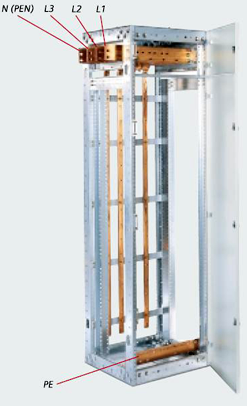
Bus system
The busbars in SIVACON 8PT enclosures are housed in a separate enclosed compartment, accessible only through steel covers bolted to the enclosure frame.
The busbars are not visible and are not accessible when the doors and covers are opened to access the rest of the cabinets SIVACON 8PT.
SIVACON 8PT cabinets have three phase power buses:
A (L1), B (L2), C (L3), the neutral operating bus bar N (or the combined neutral operating and neutral protection bus bar PEN), and the neutral protection bus bar PE.
Form of internal separation
SIVACON allows for forms of internal separation from Form 1 to Form 4 according to IEC 60439-1.

- Shell
- Internal divisions
- Busbars including distribution busbars
- Functional unit, including connection point
Form 1 – no internal division

Form 2 – separation of busbars and functional blocks

Form 2a
No separation between terminals for external conductors and busbars

Form 2b
Separation between terminals for external conductors and busbars
Form 3 – Separation of busbars and functional units + separation of functional units from each other + separation of external conductor terminals and functional units

Form 3a
No separation between terminals of external conductors and busbars

Form 3b
Separation of external conductor terminals and busbars
Form 4 – Separation of busbars and functional units + separation of functional units from each other + separation of external conductor terminals and functional units

Form 4a
External conductor terminals are not separated from the connected functional unit

Form 4b
External conductor terminals separated from the connected functional unit

Type FCB1 and BC cabinets
Cabinets FCB1 and BC equipped with air circuit breakers type 3WL v. SIEMENS rated current from 630A to 6300A, and used as:
- input cabinets;
- feeder supply cabinets;
- sectional cabinets
The circuit breaker is installed in a separate cabinet compartment. The front of the circuit breaker runs through a cutout in the door and is accessible for operation and maintenance. Depending on the enclosure configuration, the door can be either single or per enclosure compartment.
Two methods of mounting the 3WL circuit breaker in the enclosure are possible:
- fixed version – the circuit breaker is rigidly mounted in the cabinet;
- withdrawable version – the circuit breaker is installed in a basket with a withdrawable mechanism, rigidly fixed in the cabinet.
Secondary circuit equipment is placed on the doors and in the auxiliary equipment compartment of the cabinets.
Variants of enclosure designs with 3WL air circuit breakers depending on the type of connection.
Cable connection from the front
630А – 6300А

Rear cable connection
630А – 3200А

Cabinets type OFW (withdrawable module design)
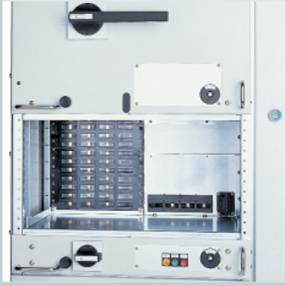
The cable or motor feeder cabinet with withdrawable modules ensures a high level of operating comfort as well as optimum safety and a high degree of plant availability. Thanks to the drawout principle, the modules can be quickly replaced or upgraded. Individual modules can be retrofitted or exchanged.
The SIVACON roll-out design ensures the highest degree of plant availability.
The vertical busbar system for the plug-in contacts runs in the rear of the enclosure and is protected against contact by a special cover (IP20).
Variants of designs of cabinets with drawer modules depending on the type of connection.
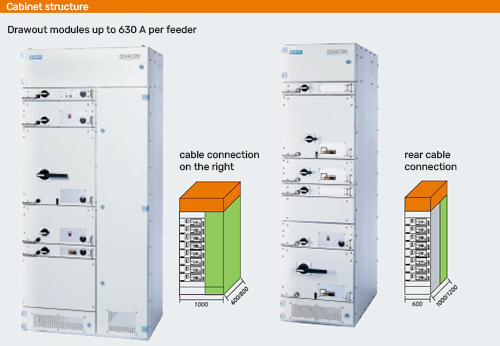
The drawout module is a combination of low-voltage switching devices (circuit breaker, contactor, relay) designed to distribute power (cable feeder) or control an electric motor of equipment (motor feeder). This equipment is placed on the mounting plate inside the withdrawable module. On the front side of the withdrawable module can be placed the control organs (control buttons, signal lamps) and measuring instruments (ammeter, voltmeter).
Depending on the composition of devices and their sizes equipment drawer modules are different heights: 100mm, 150mm, 200mm, 300mm, 400mm, 500mm and 600mm.

100 mm high drawer module (motor feeder)
Roll-out modules also provide for the use of electronic motor control and protection relay SIMOCODE PRO v.SIEMENS, which includes: a base module, current and voltage measurement module, operator panel, expansion modules: digital input / output, analog input, ground fault module. In this case, the control of the electric motor is carried out by the technological program, laid down in the base module, both autonomously and via PROFIBUS DP.

Set of electronic control and motor protection relays SIMOCODE PRO
In the cabinet, the withdrawable modules can be installed in the following positions:
- operating position;
- TEST” position;
- disconnected position.
Working position

The “TEST” clause

Disconnected position




– control contacts
– power contacts
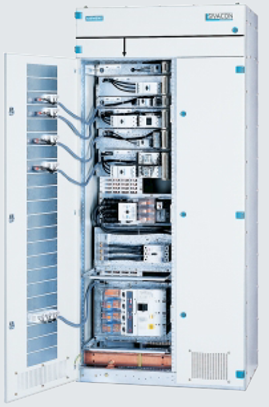
Cabinets type OFPM (plug-in module design)
SIVACON’s plug-in design provides excellent economy, reliability and flexibility. The vertical busbar system for the plug-in contacts runs in the rear of the enclosure and is protected against contact by a special cover (IP20).
Variants of cabinet designs with plug-in modules.
Without additional door cable compartment

With optional door Cable compartment door

Depending on the composition of devices and their equipment plug-in modules are different heights: 75mm, 125mm, 175mm, 275mm, 375mm.

Plug-in module with a height of 75mm
(motor feeder). Front view

Plug-in module with a height of 75mm
(motor feeder). Back view

The 125mm high plug-in module
(motor feeder). Front view

The plug-in module is 175mm high
(motor feeder). Front view
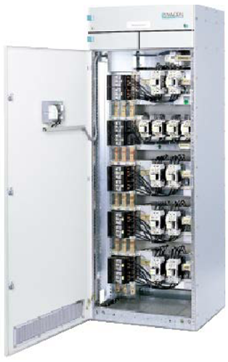
Cabinets of PFC type (reactive power compensation)
The cabinets consist of separate compensation modules, which allows a step-by-step increase in the rated power of the compensation installation. Control of switching on/off of capacitors is performed by a specialized programmable controller MODL, Germany.

The compensation module consists of: a protection device (fuses, circuit breakers), contactors with leading contacts and current-limiting resistors, capacitors.
Compensation cabinets with choke are used for centralized reactive power compensation in networks with non-linear loads (>20% of the total load). The maximum capacity of one cabinet with a 5.67% choke can be 400kVar, and with a 7% choke – 300kVar.

500kVar non-dissolved cabinet

Throttled cabinet 400 kVar

Cabinets type CCS (free design cabinet)
Free design cabinets are designed to accommodate various components and can be used for various tasks.
For example, to place in it the controller equipment, or equipment of frequency converters, a large number of low-power consumers, etc.
Cabinets can be of different configurations:
- with and without a main bus system;
- with or without a vertical busbar system;
- with one or more mounting plates.
Cables are connected from the front side of the cabinet.
Testing cabinets
SIVACON 8PT cabinets have been tested according to IEC 60439-1, DIN EN 60439-1 (VDE 0660 Part 500).
- check for limiting temperatures;
- insulation resistance test;
- check for short-circuit resistance;
- verification of proper connections between the housings of switchgear combinations and the grounding conductor according to the results of control or resistance measurement;
- checking the earthing conductor for short-circuit resistance;
- verification of leakage paths and air gaps;
- verification of mechanical efficiency;
- check of the IP degree of protection.
Before shipment, each switchgear cabinet undergoes the following controls:
- visual inspection of the workmanship, including wiring and, if necessary, inspection of electrical functions;
- insulation resistance test;
- checking of protective measures, and visual inspection of the earthing cable penetrations.
